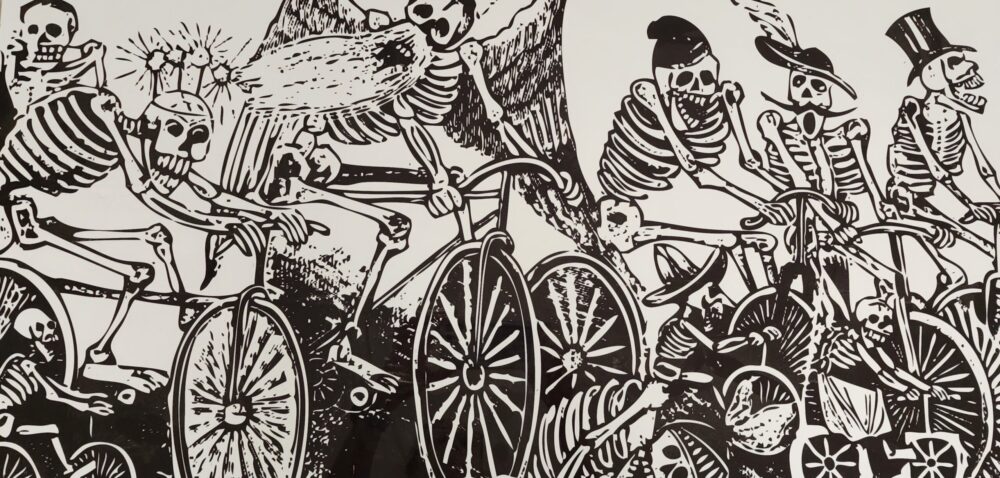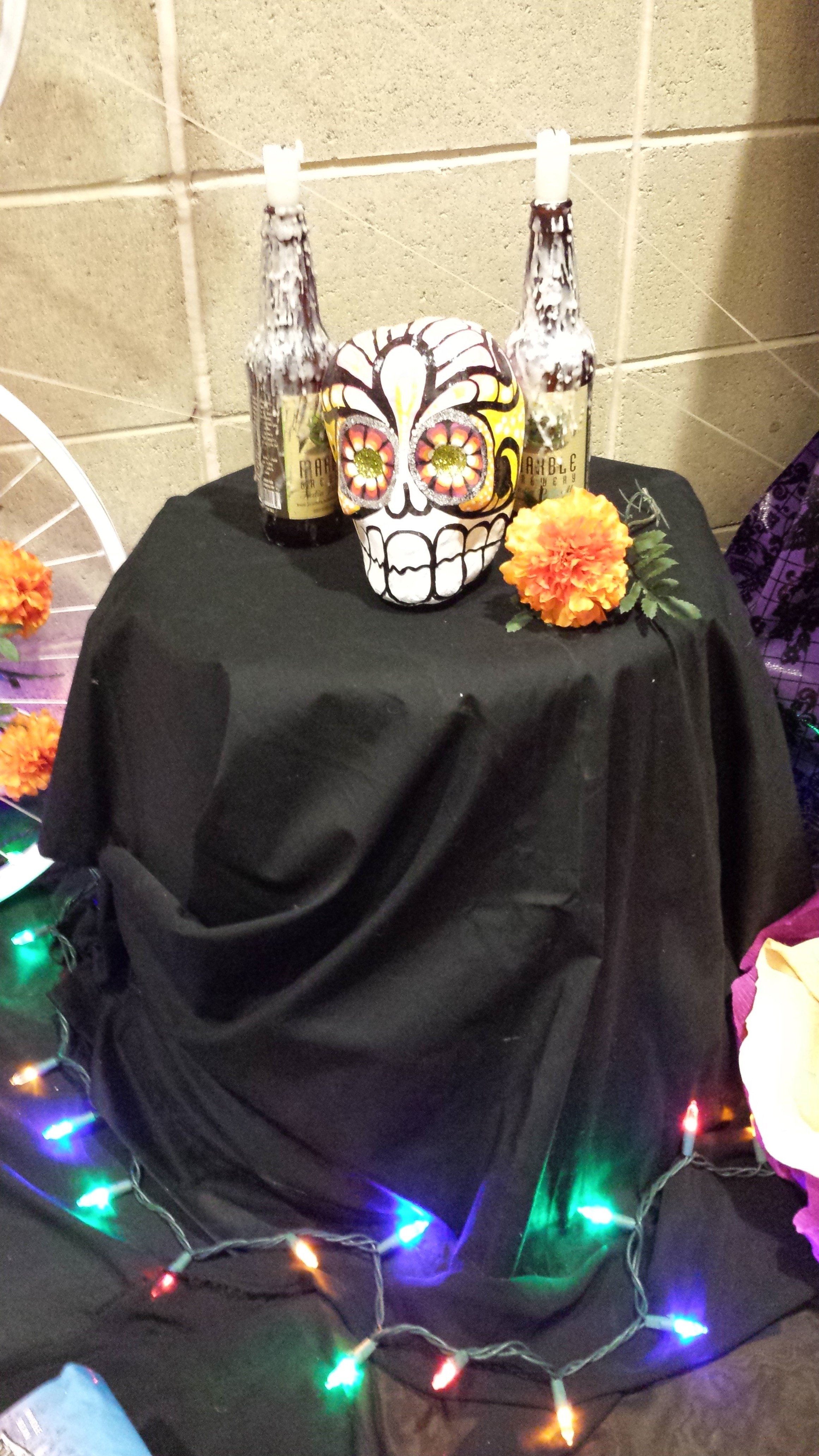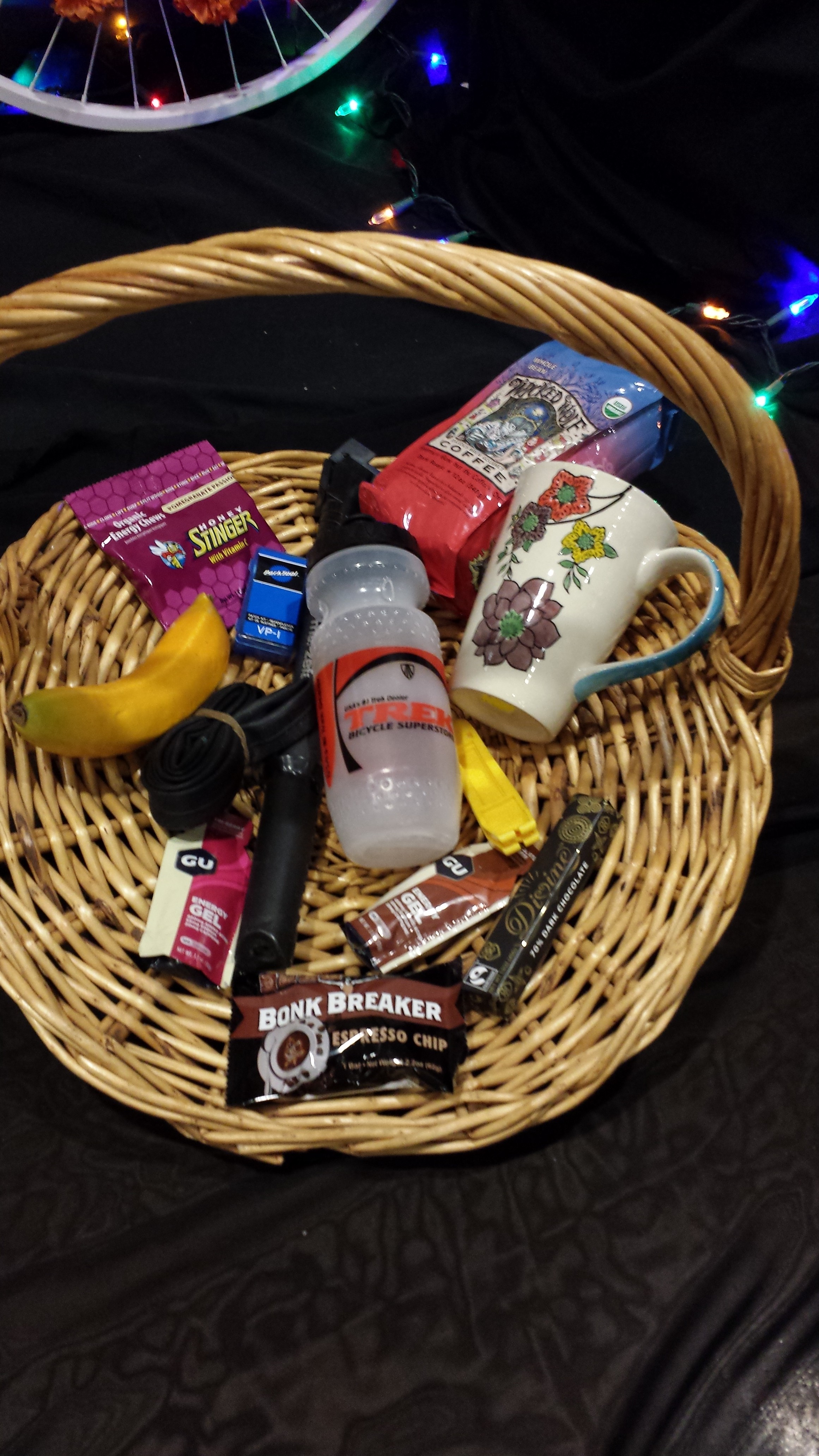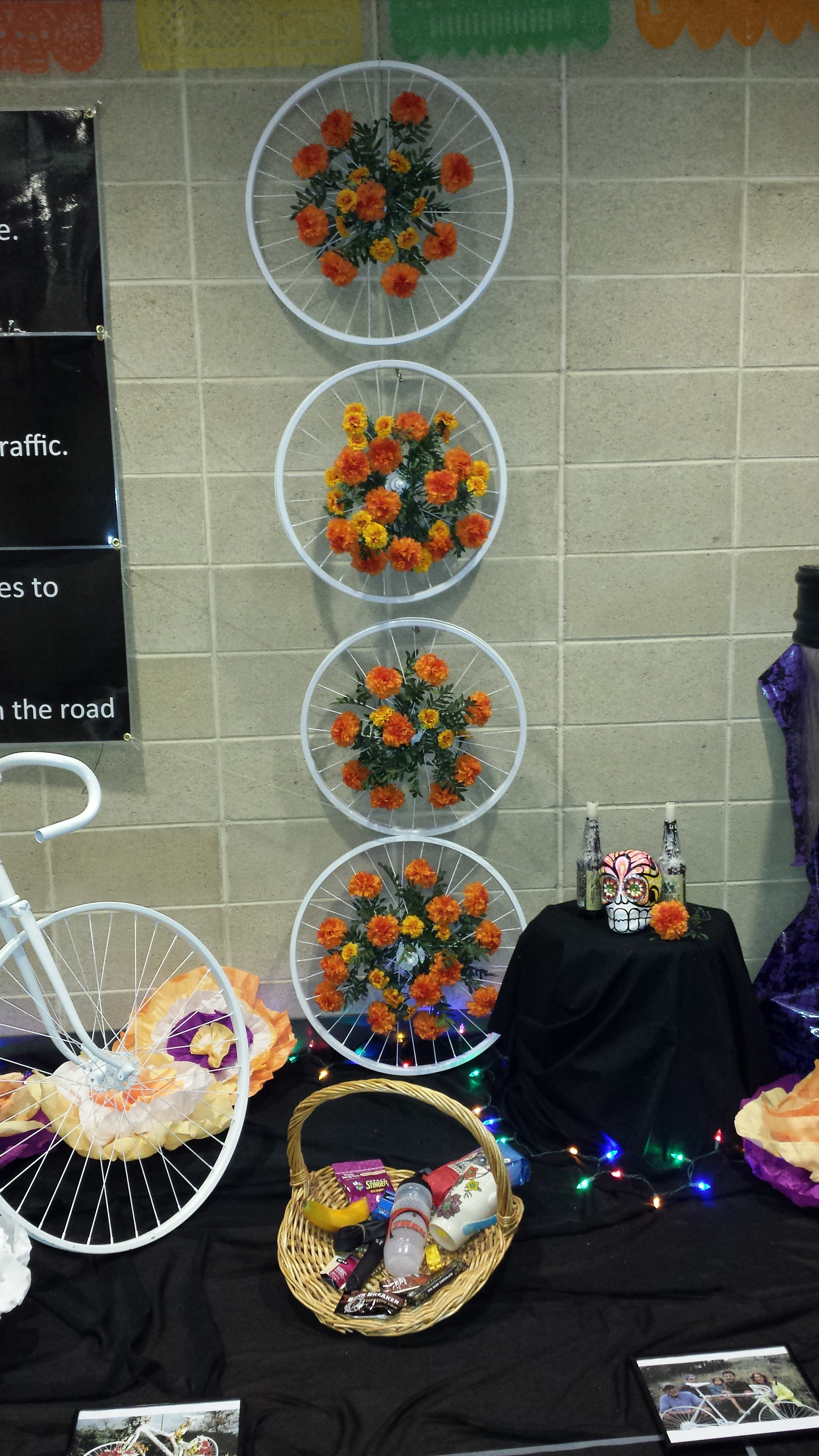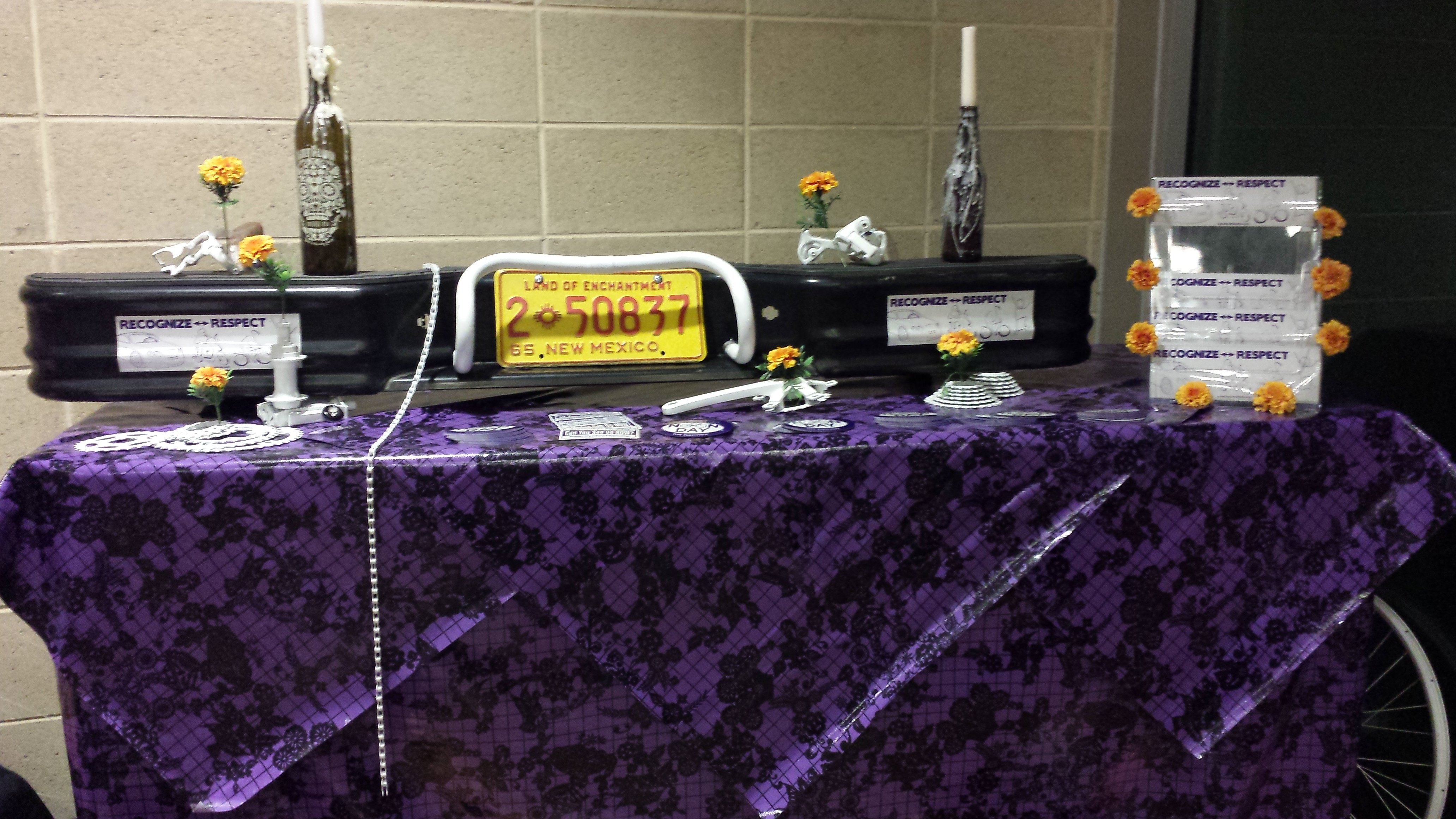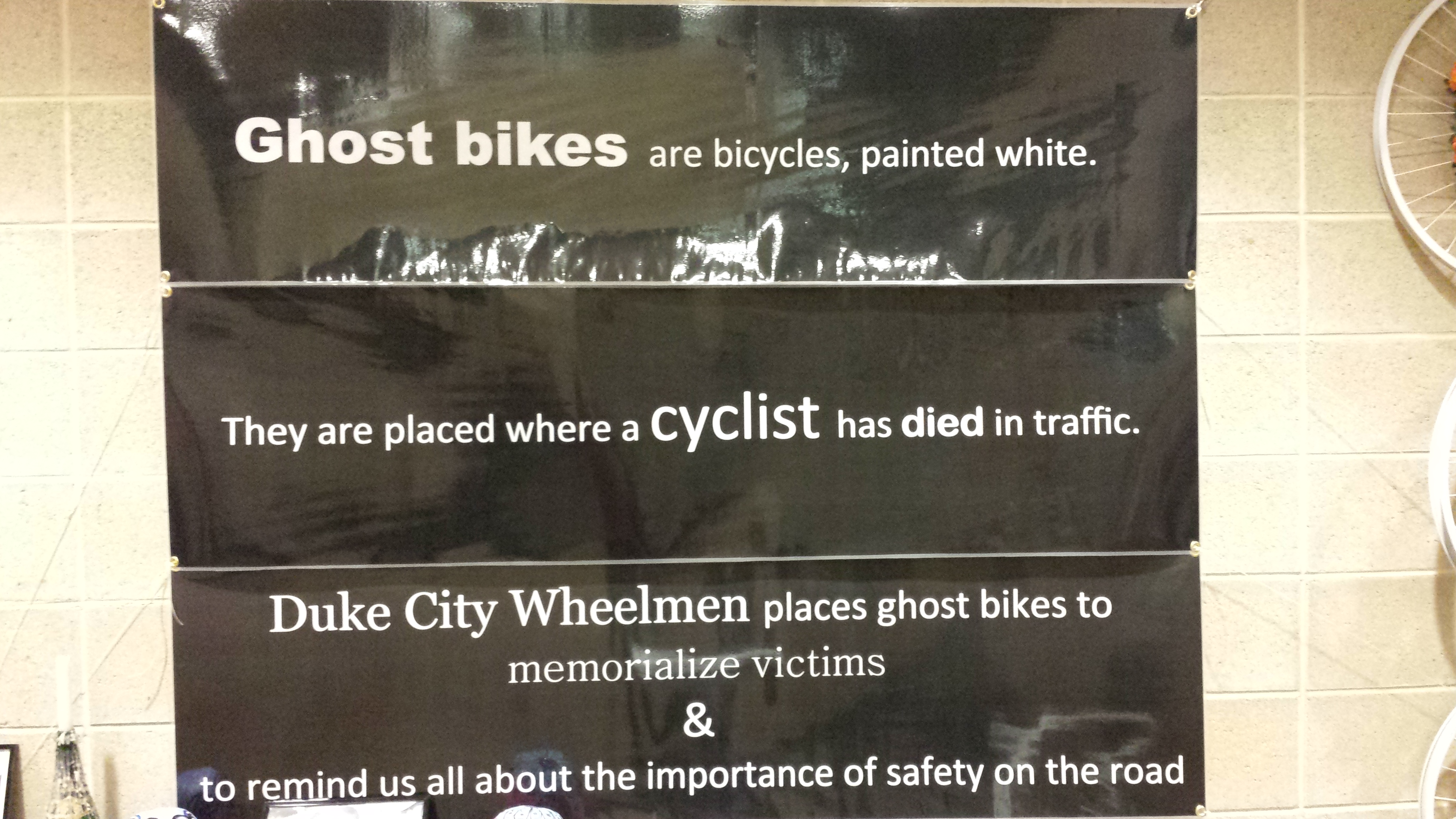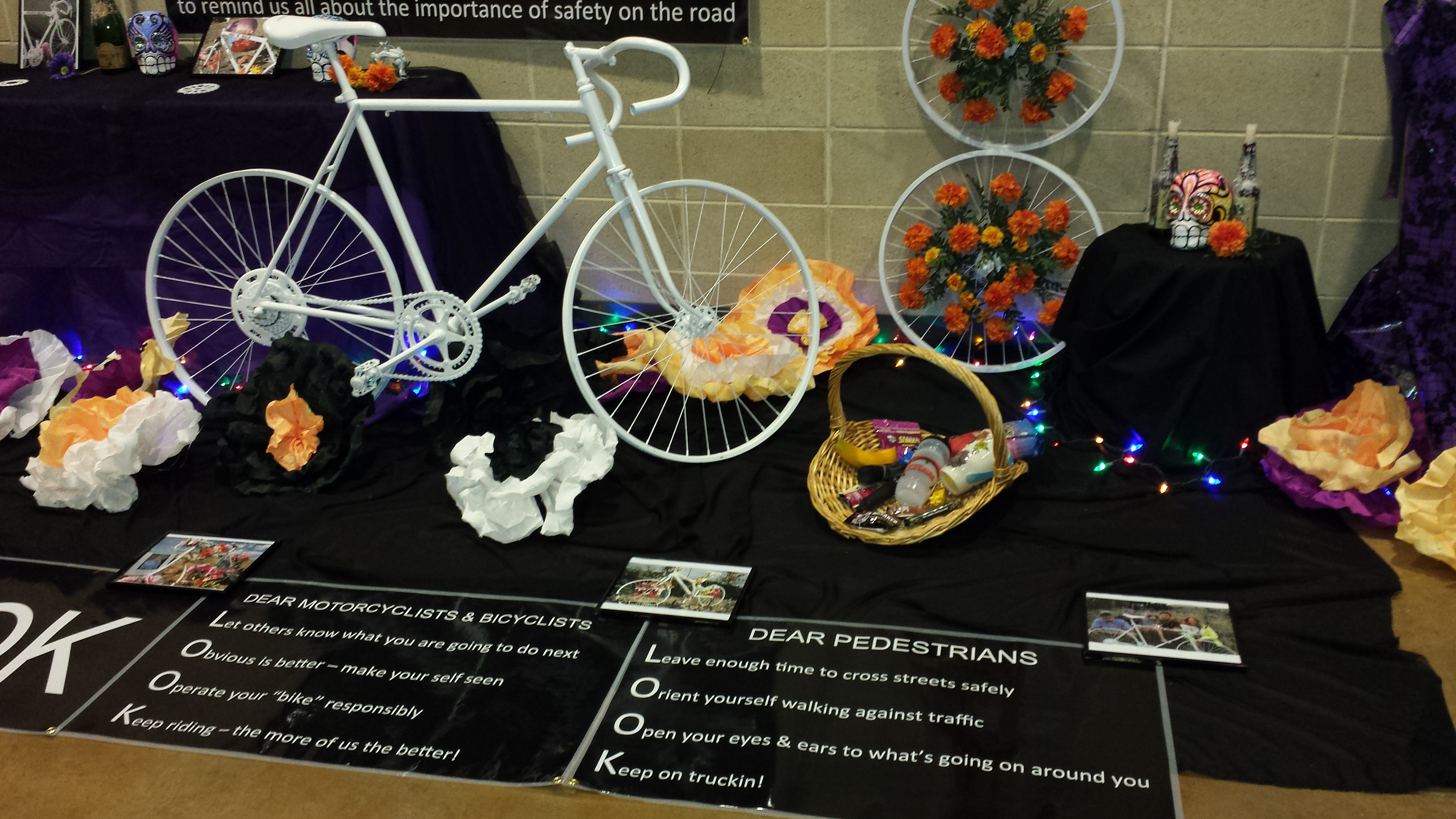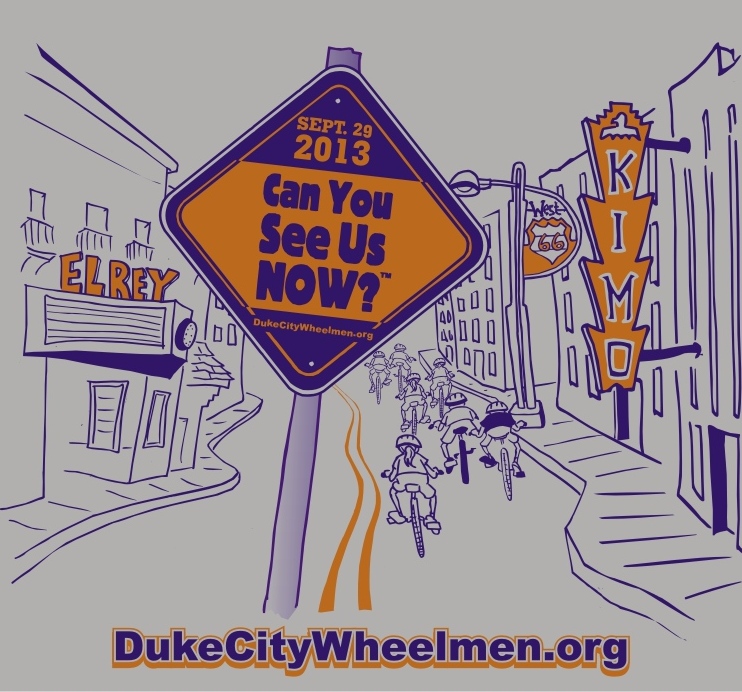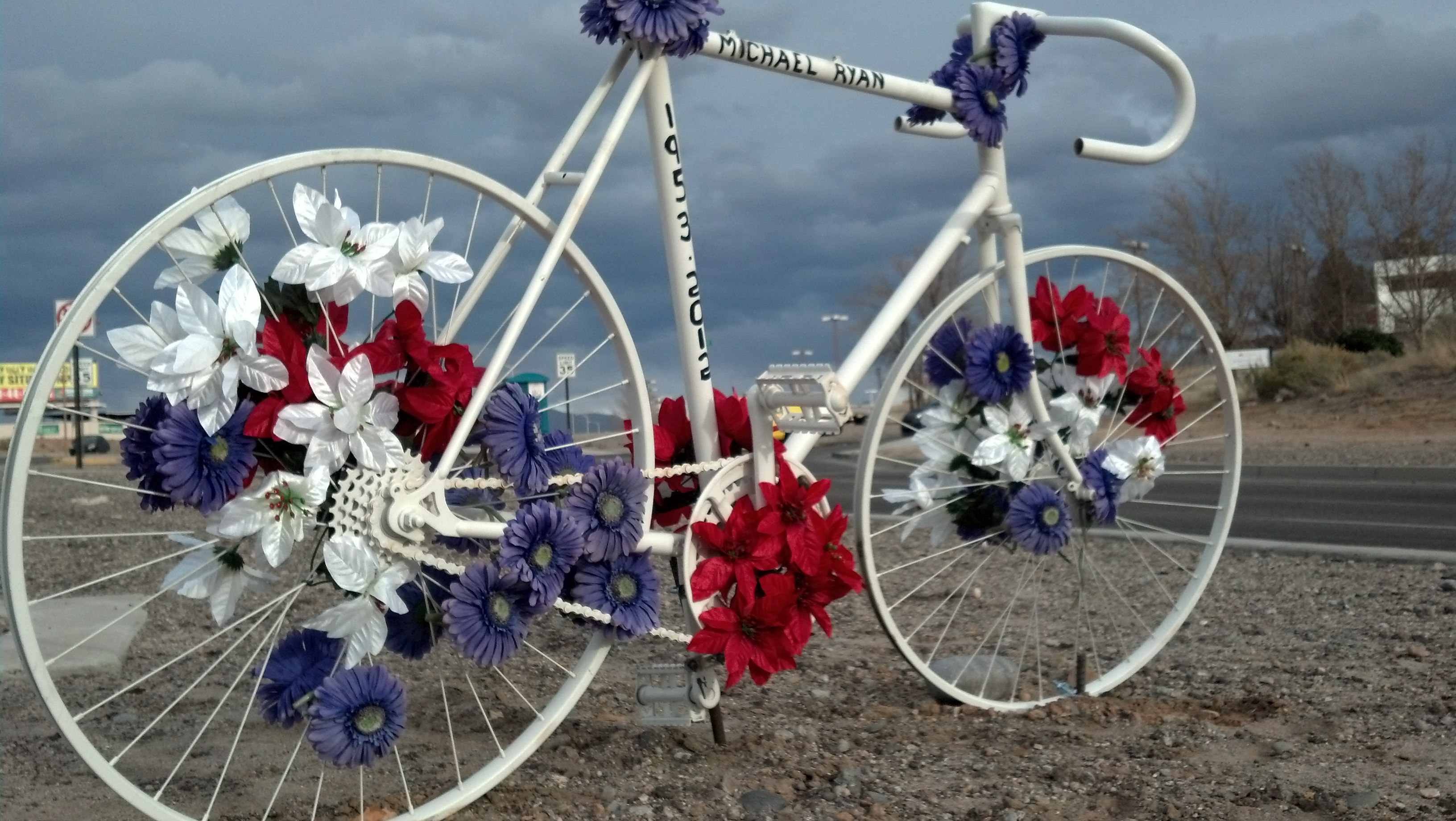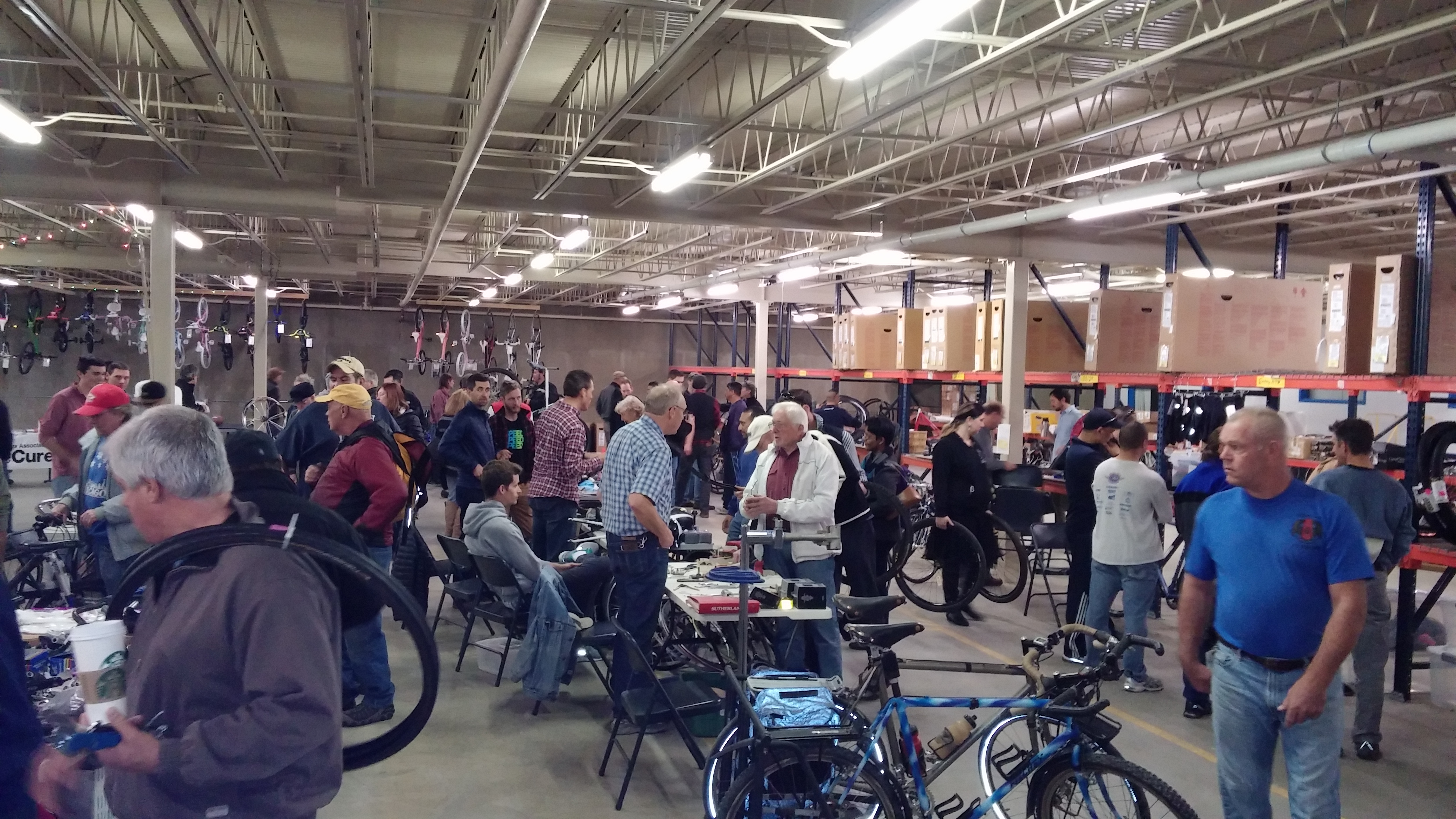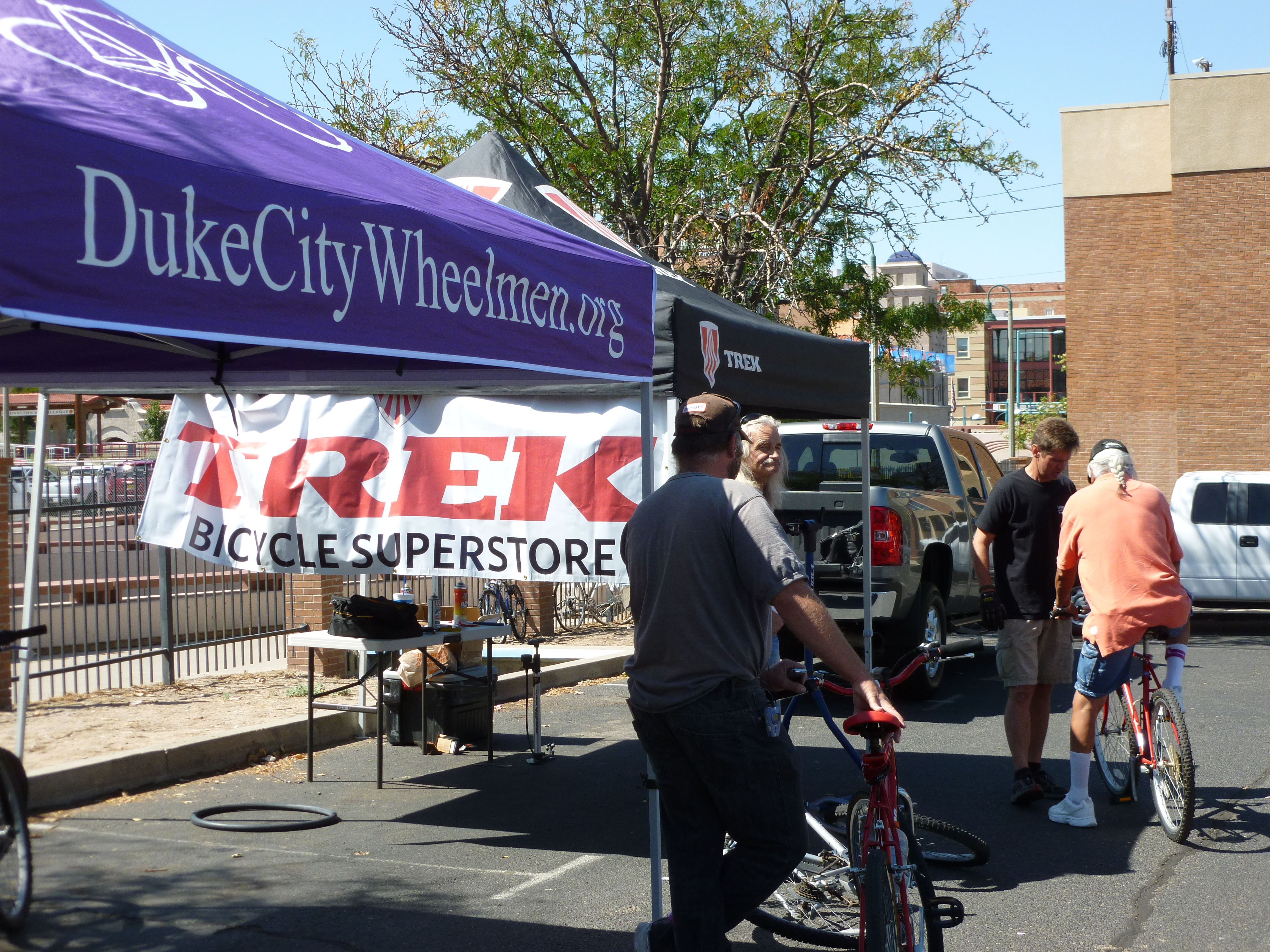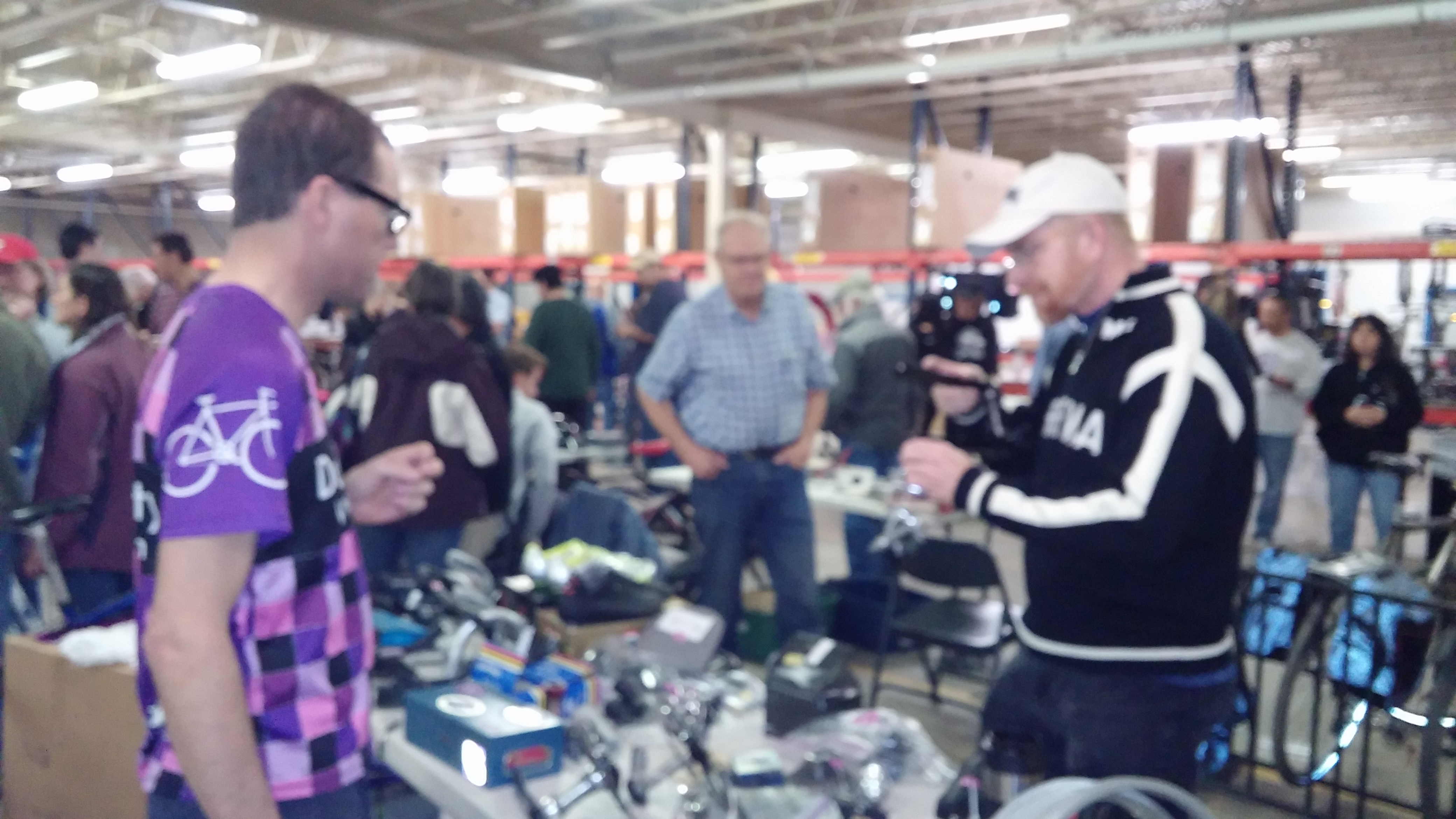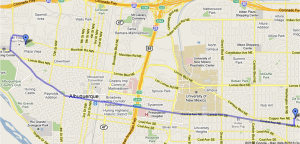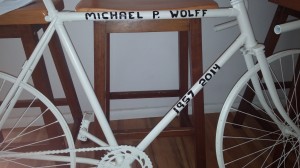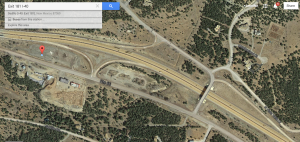This Friday, the National Hispanic Cultural Center is hosting it’s annual Community Ofrenda and Despedida evening, celebrating Dia de los Muertos. 5-7:30 pm. This free, family friendly event will be in the Dominici Education Building and on the Plaza Mayor. You can bring something to add to the community Ofrenda and tour the other Ofrendas, including the Ghost Bike Ofrenda that Duke City Wheelmen created. Look for me in DCW purple! Hope to see you there. Music and traditional refreshments will be part of the festivities too.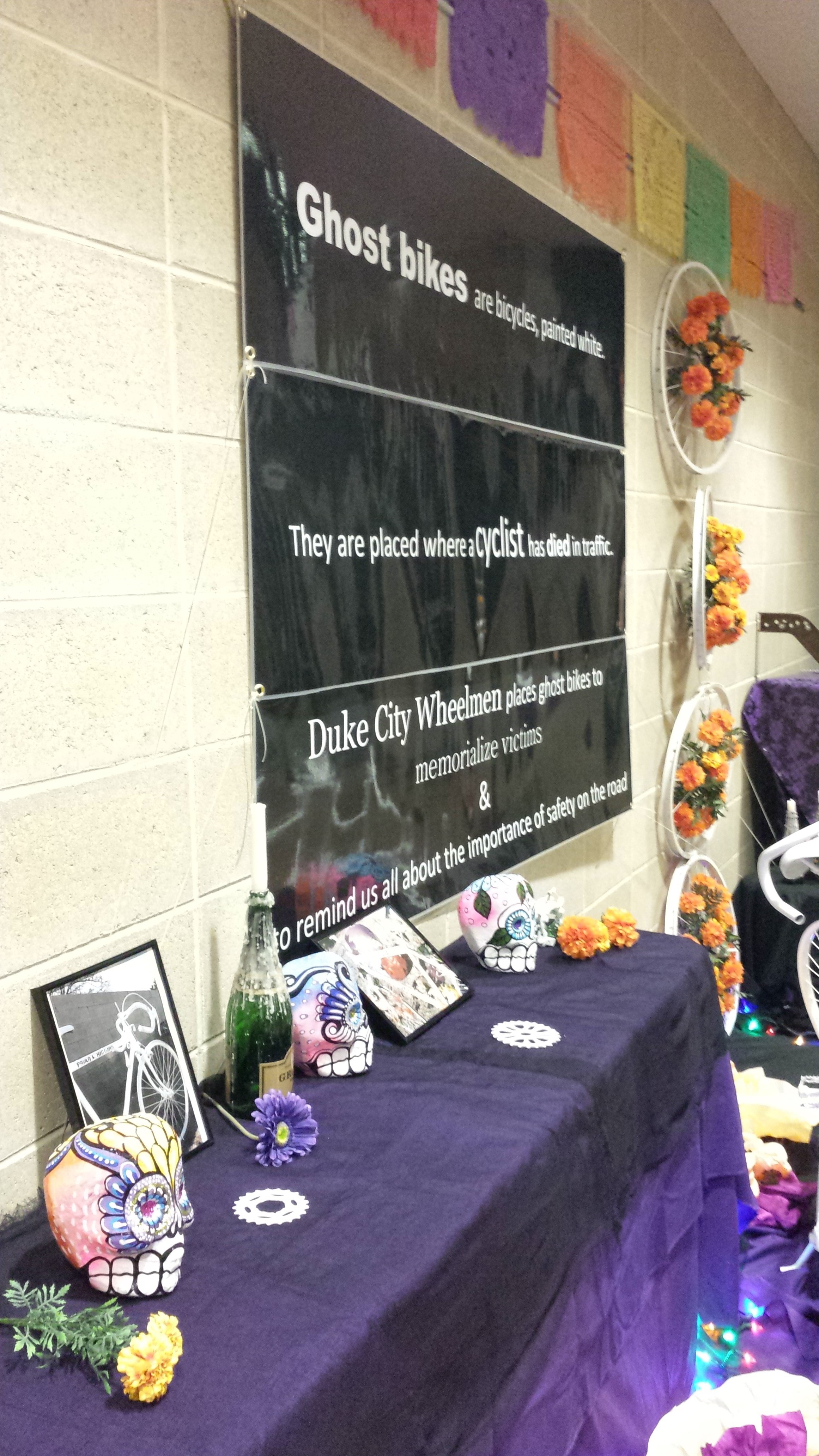
Author Archives: jb
No “Can You See Us NOW?” this year
After 5 years of putting on one of the most unique and fun, safe cycling advocacy rides, Duke City Wheelmen had to take a break this year. With faltering participation and running in the red, we just couldn’t manage the costs of the ride this year.
DCW can accept donations through United Way, PayPal, cash or check. If you want the ride back in 2016, you will have to speak with a donation!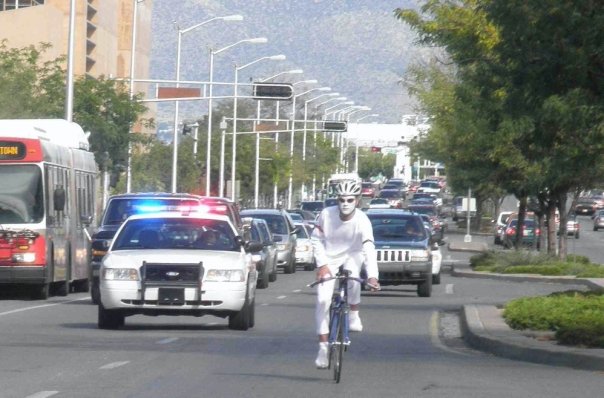 Contact me through the website if you have any questions about making a donation.
Contact me through the website if you have any questions about making a donation.
Jennifer
![]()
Ghost Bike Refurbish Day May 30, 2015

 We’ll meet at 8:30 am at the Trek Superstore. From there, teams will go out to ghost bikes, for clean up and placing new flowers. All hands welcome!
We’ll meet at 8:30 am at the Trek Superstore. From there, teams will go out to ghost bikes, for clean up and placing new flowers. All hands welcome!
We’ll send teams out with at least one Duke City Wheelmen member, someone with experienced working with ghost bikes.
Message me here, from the website, or our Facebook page for more information!
Can’t come, but want to help? Use our PayPal donation button to help pay for flowers!
Donations can also be dropped off at Trek Superstore.
Please clearly mark donations for Duke City Wheelmen.Thanks,
Jennifer Buntz
President, Duke City Wheelmen
2nd Annual Early Season Bike Swap! February 28, 2015
Please help us make this event as successful as possible by passing this information on to people you know who might be interested. The success of this event is directly tied to furthering Duke City Wheelmen’s outreach efforts, including what we do at Noon Day Ministries.

Participate! Make your voice heard: We want safer roads!!
We were 200 strong Sunday.
Thank you to all who came out in support of safer roads for every road user.
All the photos I took can be viewed here.
Special thanks to the Bernalillo County Sheriff’s
Bike Patrol Officers who participated!
6th Annual
“Can You See Us NOW?”
Bicycle Parade for Traffic Safety!
Who: YOU! This four-mile bicycle parade is something any cyclist can do.
What: This bicycle ride travels down Route 66 with full police escort at a speed slow enough for cyclists of all ages and abilities!!!
When: September 28, 2014. Bicycle Parade begins at 1:00 pm.
Rally at Tiguex Park, 2:00-3:00 pm, will include
Light refreshments
Music
Fun giveaways!
Where: Start is from University and Coal SE, CNM campus parking by Smith Brasher Hall.
Why: The purpose of this bicycle parade is to bring greater awareness of cyclists on the road and increased traffic safety for all road users.
How: Sign-up online or in person. Preregistration at http://www.newmexicosportsonline.com/Cycling/6th-Annual-Can-You-See-Us-NOW-2014/789
The event is free, but donations are welcome to help us cover expenses. With a donation of $5.00 or more you can complete your registration online and have no day-of paperwork. (Electronic signatures, as per our insurance company’s requirements, are only accepted when accompanied by a financial transaction.)
If you are unable to donate at this time, it is still helpful to complete the online registration. You will then need to stop by and complete your release before the event at the start area, University and Coal SE, from 11:00 am to 12:30 pm..
Day-of registration can also be done at the start area, University and Coal SE, from 11:00 am to 12:30 pm.
Riders will need to wear a helmet.
Costumes and bicycle “floats” welcome.
Another great event THIS weekend, September 20: www.SandiaScoot.org
Why “Can You See Us NOW?”:
- This call for improved Traffic Safety will be heard by City and State government officials in proportion to its impact.
- The impact of this event depends on the turnout.
- The turnout depends on you.
Examples abound from cities and states across the U.S. on efforts aimed at improving Traffic Safety in general, with special focus on bicycle and pedestrian safety (see links below).
Here in Albuquerque though, not so much.
That is why the 6th Annual “Can You See Us NOW?” Bicycle Parade down Route 66 is focused on Traffic Safety.
Duke City Wheelmen invites you to join us September 28, 2014 at 1:00pm to show your support for increased Traffic Safety.
Register NOW!
Safety Efforts elsewhere in the U.S.
Again and again in these efforts the idea that “we all just want to get where we are going safely” crops up. And with good reason. Who doesn’t want to be safe?
Despite the fact that NM or ABQ Government isn’t taking a lead in promoting Traffic Safety, we can take measures ourselves. Here are four simple ways each one of us can contribute:
1) Focus On Driving. Put away distractions before you start the engine or pedal off.
2) Practice Active Visual Scanning. To see all road users in plenty of time, avoid a fixed focus only on what is directly ahead.
3) Communicate with other road users. Signal, wave and say thank you. Help them understand what you will do next.
4) Be a Predictable Driver. You will create fewer surprises and increase your safety and the safety of others. Knowing and following traffic laws is the place to start for this one.
In the world of promoting Traffic Safety, there are the 3 E’s.
- Engineering
- Education
- Enforcement
The “Three E’s” are based on a simple idea that many are already familiar with; different people learn by different means. Want to reach enough drivers to improve the overall Traffic Safety? Use as many means as possible.
NMDOT Department of Traffic Safety has unveiled an anti-texting and driving campaign aimed to educate drivers on the new Statewide ban on texting and driving. They have also been responsible for some motorcycle safety awareness building, but no efforts that I know of to build public consciousness about bicycle or pedestrian safety.
Bike lanes, multi-use paths and bike routes are all engineering efforts. Some in the City are good, but as any street cyclists knows all too well, many bike lanes end at the place you need them most, at intersections! NMDOT gives us edge-to-edge shoulder pavement in some places like Tramway Blvd and parts of NM333/Route 66 in the Tijeras Canyon region. Sadly though, edge-to-edge paving and other infrastructure improvements are NOT the rule in New Mexico.
Except for the laudable education efforts of Chuck Malagodie and others with City of Albuquerque Parks and Recreation Department and the Esperanza Community Bicycle Shop, we have seen very little from the City of Albuquerque to promote Traffic Safety.
In fact, the City of Albuquerque has taken traffic law enforcement off the table for the Albuquerque Police Department.
“The number one goal for the Albuquerque Police Department is crime prevention and we really want them working on that, traffic issues, we’d rather work with,” said Michael Riordan, acting director of the city’s Municipal Development Department. “There’s 3 E’s: engineering, education and enforcement, and we’re trying to do as much engineering as we can to limit what they have to do. APD has 19 officers devoted to traffic.”
That was as of a year ago, August 2013. I’m told that now, August 2014, the Traffic Division of APD has 12 officers.
Although Traffic Safety does receive some attention from City and State officials, it isn’t enough. Right NOW, traffic safety needs YOU!
Imagine if everyone concerned about traffic safety and the safety of cyclists rode together on September 28…
You, your friends and family, multiplied by the thousands….
Think about the statement that would make…
Do you want our City policy makers to take traffic and cyclist safety more seriously? Come SHOW your concern.
Without YOU, this success of this event won’t be what it should be.
You can sign-up today, right NOW in fact.
“Can You See Us NOW?” 2014
Mark 9/28 to join us for this annual parade down Central AVE.
a.k.a. Route 66 or the Mother Road
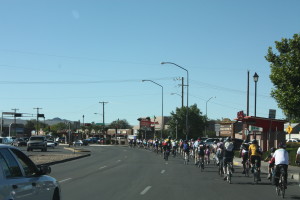
Ride with us! Add your voice to the call for traffic safety.
Separate and UNEQUAL
In April and again in June people using multi-use paths in Santa Fe that cross Rail Runner tracks rode out into the path of an oncoming train. These two individuals died. These multi-use paths have no safety arms or warning lights of their own.
On the other hand, people using city streets in Santa Fe while (typically) driving motor vehicles, encounter warning lights and arms specifically designed to stop them from driving into the path of the very same trains.
No one questions the presence of these safety devices on streets or highways. Departments of Transportation across the country realize that people need help in avoiding these collisions. Rail Runner/street crossings that don’t have arms or warning lights have been sites of motor vehicle/train crashes elsewhere in the State (between Los Lunas and Belen). Pedestrians have been killed at other unmarked crossings in Bernalillo County.
When considering multi-use paths, it isn’t accurate to think only cyclists use them. Path users routinely include children, elderly, disabled people, or those without the means or inclination to drive a motor vehicle. They also include those crazy enough to exercise outdoors – cyclists, runners, walkers, roller bladers, etc.
Are any of us really comfortable saying that this diversity of path users should be held to a higher personal standard for their safety at a track crossing compared to motor vehicle drivers? Said another way;
Why not protect all road and path users equally?
A website devoted to train track crossing safety posted A motorist is almost 20 times more likely to die in a crash involving a train than in a collision involving another motor vehicle. Comfortably, I’ll say that the likelihood of a path user dying from being hit by a train is even higher.
These crashes are always difficult to understand. What are people thinking? How can they not see or hear the train? Both the recent victims of bicycle/train collisions lived in Santa Fe. How could they not know about the trains!?
You might think that the closer we are to home the more familiar we are with potential hazards, like on-coming trains, and the better we would be at avoiding those hazards. If you do think that, think again. According to the National Highway Traffic Safety Administration (NHTSA) at U.S. DOT:
Three out of four crashes occur within 25 miles of a motorist’s home. Fifty percent of all crashes occur within five miles of home.
What this says to me is that people are, well, people. We make mistakes. We get comfortable with what is the most familiar and sometimes that lets us drop our guard. While this can be a good thing in an interpersonal relationship, it isn’t so good with respect to traffic safety.
As people, we are all quite susceptible to falling into that zoned out, less observant state of mind. I feel that equal protection from our own potential foibles is in order, no matter how we choose to be mobile on a given day.
I just can’t advocate for separate but unequal.
Ghost Bike for Michael Wolff
On Friday evening Duke City Wheelmen will place a ghost bike for Michael Wolff. He was hit while cycling on June 6, 2014 and passed away due to the injuries he sustained on June 14, 2014.
The ghost bike will be dedicated at 6:30 pm. This is the same time, and day of the week, that Michael was hit.
The family extends an open invitation to cyclists, and people concerned about traffic safety in general, to come to this ghost bike installation.
The driver of the car who hit Wolff fled the scene after the crash. Due to the diligence of Bernalillo County Sheriff’s Officers, 21 year-old Shilo Sap has been identified as the driver of the vehicle that hit Wolff. Sap has been arrested and charged with leaving the scene of an accident resulting in great bodily harm/fatality and careless driving.
Michael Wolff’s ghost bike will be the 30th that Duke City Wheelmen have placed in New Mexico for cyclists who have died while riding, from as long ago as 1984.
Directions:
The bike will be placed near a small memorial already at the crash site, in a location visible from the road. Sandia Trailer Sales & Service, 1435 HWY 333/Route 66, is a landmark close to where the crash occurred. The owners of East Mountain Dance, 1427 HWY 333/Route 66, have opened their parking lot to those driving to the dedication. To get to the site, take I-40 east bound from Albuquerque. Exit I-40 for NM-333 toward Sedillo, exit number 181. The ghost bike installation site is about 2.5 miles east of the I-40 exit #181.
Albuquerque Police Department
At least three cyclists were pulled over while riding on the Tramway shoulder on March 25 and were warned (no citation) by the APD Officer that what they were doing was illegal. He told them to “look it up” when he was asked what ordinance he was enforcing.
“He said they were just giving out warnings now, and about to start handing out tickets.” This seems very reminiscent of what the cycling community went through a few years back….
City Council office (768-3100) provided the following info:
Ord. # O-11-46 was passed (8 in favor, 1 opposed) by City Council on 3/21/2011: Amending Sections 8-2-1-44(A) And 8-3-3-6 ROA 1994 To Remove The Prohibition On Bicycles Using Limited Access Roadways That Have Not Been Posted To Prohibit Bicycles
The ordinance was signed into law on April 5, 2011 by Mayor Berry.
If you care to find the ordinance, go to www.cabq.gov/council
(On left hand side choose “legislation”, then click on the link for “pending & adopted legislation” enter the ord #, the year (2011) and then click on “search”)
The Foothills APD station it turns out is the “home” station for Officer Riley (car L61) who pulled the cyclists over
This is minor to being shot by APD, but it is all part of the same problem. There is new information in the news that reveals problems with the training candidates receive. In addition to issues with the training, APD has lost so many senior officers, there is almost no one there for the long period of on-the-job training it takes for rookies to become good officers. With the Justice Department investigation ongoing & moral at rock bottom, recruiting quality candidates to the job is also a huge problem. Also, you can be sure that no officers are receiving the specialized training it takes to investigate a crash involving a motor vehicle and a bicycle or pedestrian.
All this in turn leads to a breakdown of police effectiveness across the board, from traffic safety to burglaries or other policing issues. These police shootings are the most outrageous, but everywhere you look APD is compromised. All of us are affected; this is not an issue just for the “homeless.”
For cyclists and pedestrians, the way that the Traffic Division is compromised leads to a lack of due diligence when investigating motor vehicle/bicycle or pedestrian crashes. This in turn will make it virtually impossible for anyone to be charged when there are severe crashes that result in great bodily harm or death. In addition, unlike a 1997/98 APD effort to actually enforce traffic laws today we have an “engineering” approach to bringing traffic under control.
This is a big issue. Most people are not aware of the extent of the problem within the Albuquerque Police Department. One way this all impacts cyclists and pedestrians is that the Traffic Division comprises the only people who have any chance at all to tell the stories of victims of severe crashes. Without training and being able to accurately document crash scene evidence, no accurate picture can be painted of what happened and victims have no voice.
I’m not anti-cop. What I want from APD is for the officers to be able to do (so much) more than pull the trigger.
Jennifer Buntz
